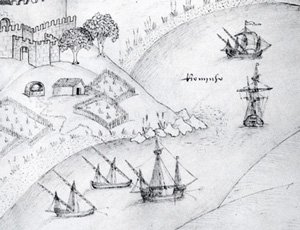
Burying people who died of plague – the Late Middle Ages
The Mongol Empire
In the Late Middle Ages, the Mongol Empire brought peace to most of Asia, and encouraged trade along the Silk Road. Poland, Russia, and Italy profited from this trade. Europe was making more and more stuff to sell on the Silk Road, especially wool cloth.
Who were the Mongols?
History of wool
The High Middle Ages
Late Middle Ages timeline
All our Medieval Europe articles
The Hundred Years’ War and the Plague

Joan of Arc (painted about fifty years after she was killed)
By the early 1300s, however, the Mongol Empire was collapsing, and trade became much more difficult. In addition, England and France began to fight the Hundred Years’ War, which made both England and France much poorer.
Hundred Years’ War
Joan of Arc project
St. Crispin’s Day
The Black Death
What is the Silk Road?
Germany and Italy fought a long series of wars as well. All of these wars were made much worse by the Black Death, or bubonic plague, which spread along the Silk Road from China to Europe starting in 1328, killing millions of people and causing the collapse of the Mongol Empire.
Europe gets into manufacturing
By the 1400s, after the plague, Europe looked very different. The wars were over. The plague was mostly over. Europeans stopped selling enslaved people, for the most part. Now Europeans were making and selling not just wool cloth but also paper, sugar, cotton, and steel.

Medieval paper mill in Fabriano, Italy, established in 1276 AD
History of paper
Sugar in the Middle Ages
Where does cotton come from?
Ancient and medieval steel
Sailing the Atlantic Ocean
Europeans started to look for better places to grow sugar and cotton, with cheaper workers – with enslaved workers. And the end of the Silk Road forced traders to look for other ways to get things from China and India. Explorers were figuring out how to sail from Europe around Africa to China.
History of slavery
Medieval ships and sailing
Who are the Ottomans?
Christians in Spain
The Caribbean

Caravels, about 1500 AD (Livro das Fortalezas de Duarte Damas)
In 1453, the Ottomans conquered the last traces of the Roman Empire in Constantinople. In 1492, Spain forced the last Muslim rulers out of Granada (and the Jews). And in the same year, Columbus arrived in the Caribbean: perfect for growing sugar and cotton, once he had killed most of the people who lived there.
Learn by doing: a day in medieval Europe
More about the Renaissance
More about medieval Africa
Bibliography and further reading about medieval history:
The Holy Roman Empire and Charlemagne in World History, by Jeff Sypeck (1997). An exciting and accurate account of the formation of one of Europe’s great empires.
Beyond the Myth: The Story of Joan of Arc , by Polly Brooks (1999). Accurate and thoughtful, with good illustrations and maps, though more a biography than a history.
Constantinople: The Forgotten Empire, by Isaac Asimov (1967). This book got many future Byzantinists started on their path. It’s out of print, but you can get it used.
A Little History of the World, by E. H. Gombrich (2003). Written in 1935, the history is a little out of date, of course, but it is written to convey the facts of all of human history to young people, and I think it does a good job.